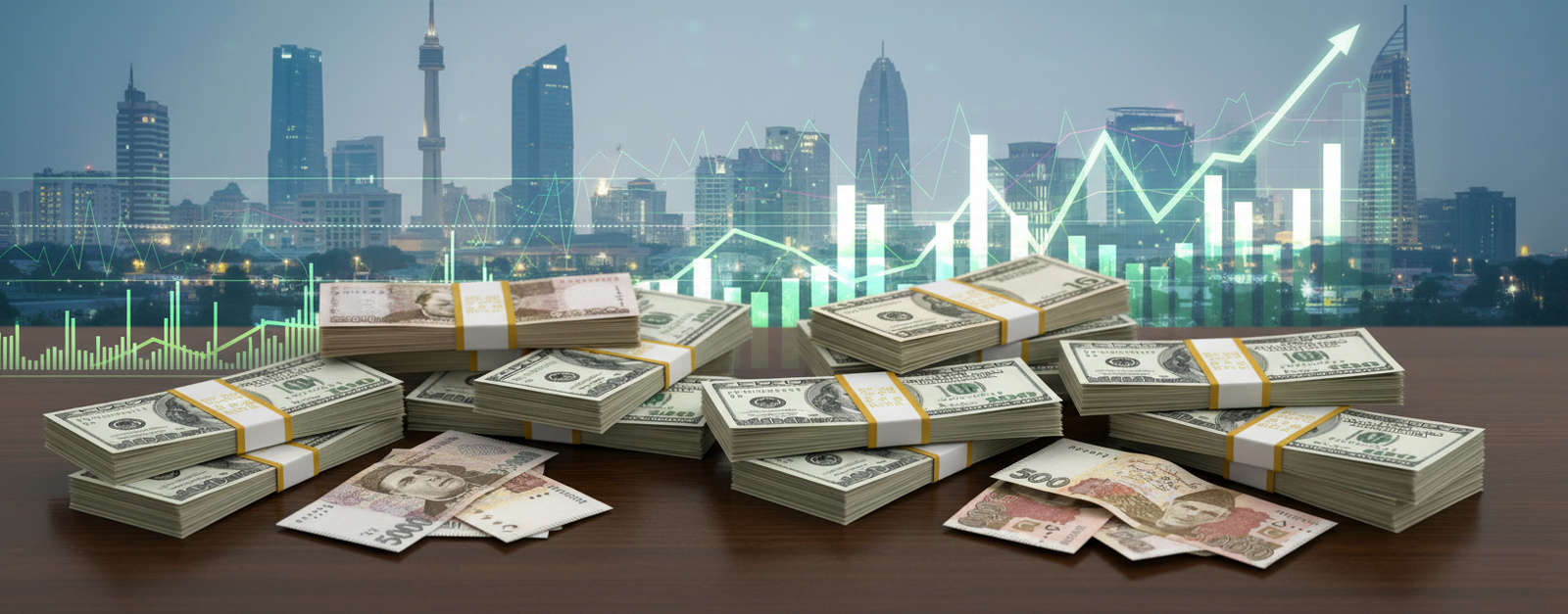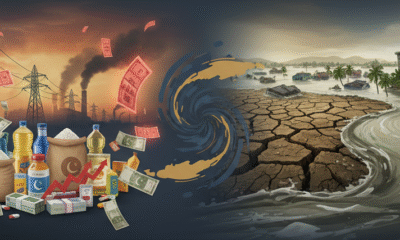Business & Economy
Is Pakistan’s Economy Improving?

Over the past two years, Pakistan has swung from crisis management to cautious stabilization. Power tariffs, inflation shocks, and a once-crippling policy rate forced households and firms into survival mode. Since mid-2024, however, several fundamentals have started to heal: inflation has cooled markedly, interest rates have been cut, the current account has improved, and multilateral support has been renewed. In short, the Pakistan Economy appears to be edging from firefighting to a fragile—but real—recovery.
Below is a clear, data-anchored look at where things are improving, where they’re not, and what to watch next in Pakistan.
1) The quick snapshot: where the dial moved
- Inflation: Headline inflation decelerated sharply from 2023 peaks, with monthly prints in early and mid-2025 touching the low single digits; authorities framed their medium-term goal in the 5–7% range. This downshift created room for monetary easing. Reuters+1
- Interest rates: From a 22% peak, the State Bank of Pakistan (SBP) cut in successive steps through 2024–25, bringing the policy rate near the low double digits by mid-2025 as price pressures cooled. Reuters+2State Bank of Pakistan+2
- External balance: After a 2024 deficit, the current account swung toward balance and even posted a surplus for FY2025 on the back of softer imports and robust remittances, though monthly volatility persists. State Bank of Pakistan+2The Express Tribune+2
- IMF anchor: Pakistan moved from a short Stand-By Arrangement (SBA) to a longer Extended Fund Facility (EFF), with the first EFF review completed in May 2025—keeping reforms and financing on track. IMF+2IMF+2
- Growth: The IMF’s baseline sees growth rebuilding gradually—tempered but improving amid reforms and easing financial conditions. Profit by Pakistan Today+1
Bottom line: Macro stabilization has gained traction in Pakistan, but it remains vulnerable to energy sector slippages, commodity swings, and reform fatigue.
2) Inflation & interest rates: relief, with caveats
Inflation reset
Inflation’s rapid descent in 2025—helped by base effects and food price normalization—has materially changed the operating climate for businesses and consumers. The pace slowed to its weakest in years earlier in 2025, before normal seasonal bumps around Ramzan and weather-linked food pressures. Reuters
Monetary easing
With inflation cooling, the SBP pivoted from record-tight policy. Since mid-2024, cumulative cuts have rolled back a hefty portion of earlier hikes; by mid-2025 the policy rate had fallen around the low-teens, with expectations for further gradual easing contingent on inflation staying within target. For credit-starved firms, this is meaningful: working capital becomes more affordable; investment cases that didn’t pencil at 22% start to clear. Reuters+2State Bank of Pakistan+2
What to watch: Food inflation (sensitive to weather and logistics), administered prices (energy), and global oil. If these flare, the easing cycle could slow or pause.
3) External accounts: stabilization, not mission accomplished
Current account and trade
Policy-led demand compression and better remittance inflows helped narrow the external gap. Pakistan even recorded a current account surplus for FY2025—a symbolic milestone after prior deficits. But the monthly picture remains choppy: July 2025 slipped back into deficit as imports normalized and services outflows persisted. In other words, momentum exists, but it’s not yet automatic. The Express Tribune+1
Remittances & exports
Remittances continue to serve as a shock absorber. Exports have shown pockets of resilience (particularly when the exchange rate is competitive), but energy costs and periodic import constraints still weigh on export scale-up. Maintaining predictable input availability and energy sector reforms will be key to unlocking exports beyond cyclical upswings. State Bank of Pakistan
4) The IMF anchor: why it matters
Pakistan’s engagement with the IMF shifted from the short SBA (concluded in April 2024) to a multi-year EFF in 2025. The EFF aims to address structural weak points—tax mobilization, energy sector losses, SOE reform, and climate resilience—rather than offering only stop-gap financing. Completion of the first EFF review unlocked fresh funds and, more importantly, policy credibility with other lenders and markets. IMF+2IMF+2
Why this is stabilizing:
- It reduces uncertainty about near-term external financing.
- It conditions reforms that lower quasi-fiscal losses (especially in power).
- It can catalyze additional support from the World Bank and others—indeed, a 10-year partnership framework of sizable scale was announced in early 2025. Financial Times
5) Growth: rebuilding, but below potential
Consensus growth expectations remain modest. The IMF’s updates around mid-2025 pointed to a gradual recovery path (with projections in the 2–4% zone depending on fiscal year and scenario), below Pakistan’s potential and aspirations. To raise trend growth, Pakistan needs sustained reform follow-through—particularly on revenue, energy, and competitiveness. Profit by Pakistan Today+1
Key swing factors for growth in Pakistan:
- Energy sector fixes (loss reduction, timely tariff adjustments, circular debt management).
- Investment climate (policy predictability, contract enforcement, and capital access).
- Export sophistication (moving up value chains, logistics, and services exports).
- Human capital & climate resilience (health, education, water, and flood protection).
6) Fiscal policy: difficult but doable
The 2024–25 and 2025–26 budgets emphasize revenue mobilization and expenditure restraint, with plans to broaden the tax net and reduce untargeted subsidies. This is politically hard—especially when real incomes are under pressure—but essential for debt sustainability and for creating space to invest in growth-enhancing priorities (education, primary health, climate adaptation, and targeted social protection). Overshooting on ad-hoc levies can choke growth; undershooting invites financing stress. The credible middle path is steady base-broadening, digitalization, and compliance enforcement. AP News
7) Credit, jobs, and the real economy
As rates ease and inflation stabilizes, banks can gradually pivot from risk-off liquidity parking toward private-sector lending. SMEs—especially export-oriented and tech-enabled ones—stand to benefit. But capital scarcity won’t vanish overnight, and cost-reflective energy prices still bite.
Labor market: A cooler inflation pulse should help real wages stabilize. The medium-term jobs engine, however, remains investment-led manufacturing, construction, agribusiness, and tradable services. For a demographic dividend to pay off, Pakistan must boost female labor force participation, formalize micro-enterprises, and scale digital skills.
8) The energy bind: the toughest knot
The power sector’s circular debt, high generation costs, and losses continue to weigh on competitiveness and public finances. Without durable line-loss cuts, governance fixes, and better fuel/contract management, periodic tariff jumps will recur—undermining industrial planning and public support for reforms. The EFF explicitly flags these priorities, making this sector the bellwether of Pakistan’s reform seriousness. IMF
9) Risks that could derail the progress
- Commodity prices: A renewed upswing in oil or key food commodities would pressure inflation and the current account simultaneously.
- Climate shocks: Floods or droughts can upend food prices, exports, and infrastructure. Pakistan’s climate vulnerability is macro-critical. Financial Times
- Policy slippage: Back-tracking on revenue or energy reforms could spook financing and stall easing.
- Global conditions: Tight global liquidity or weak trading partners would complicate external financing and export growth.
10) Reasons for cautious optimism
- Anchored program: The multi-year IMF framework and parallel multilateral support reduce tail risks and support market confidence. IMF+1
- Disinflation achieved: Lower inflation creates room for real incomes to recover and for investment cases to revive as borrowing costs decline. Reuters+1
- External breathing space: A narrower current account need not mean stagnation if export growth and remittance strength are sustained alongside import normalization. The Express Tribune
- Ratings and sentiment: Improvements in external metrics have already fed into better risk perceptions among some rating agencies and investors. S&P Global
11) What this means for businesses in Pakistan
- Plan for easing, not free money: Funding costs should trend down as inflation stays contained and SBP continues a gradual easing path—but expect a stop-go pattern if imported inflation flares. Keep debt maturities staggered. State Bank of Pakistan
- Price with volatility in mind: Input costs (especially energy) remain the big swing factor. Use hedging where possible; negotiate pass-through clauses in contracts.
- Lean into tradables: A more competitive exchange rate and export facilitation can support manufacturers and IT-enabled services. Diversify markets; upgrade product quality and certifications.
- Digitalization is a tax strategy: As authorities widen the tax net, transparent, digitized invoicing and compliance reduce audit risk and unlock incentives. AP News
- Climate-proof operations: Invest in water stewardship, flood-resilient sites, and energy efficiency; financiers increasingly favor climate-aligned capex. Financial Times
12) Outlook: the path from stability to momentum
The near-term story is about consolidation: keeping inflation within target, continuing measured rate cuts, maintaining an orderly external account, and pushing through energy and revenue reforms. Growth can gradually lift as confidence returns, private credit recovers, and export capacity expands.
The medium-term story must be transformation: scaling investment, formalizing the economy, and moving up the value chain—especially in agro-processing, textiles-to-tech, logistics, and high-value services (IT, design, remote professional services). With the right sequencing—energy fixes first, tax base-broadening, and a predictable policy framework—Pakistan can shift from boom-bust cycles to steadier 4–5% trend growth, and then higher.
For the Pakistan Economy, lower and stable inflation, a credible reform anchor, and improved external metrics are necessary conditions—not sufficient ones. The sufficiency test will be whether reforms translate into cheaper, more reliable energy; a fairer, broader tax base; and an investment climate where export-oriented firms can scale without policy whiplash.
13) Conclusion
So, is it improving? Yes—select indicators are undeniably better than the crisis days: inflation has cooled, rates are down from their peak, and the external account has steadied under an IMF-anchored program. But “better” isn’t “there.” Structural fixes—especially in energy and revenue—will determine whether these green shoots become durable growth. If reform momentum holds and climate/commodity shocks are managed, the Pakistan Economy is moving from stabilization toward a slow but sturdier recovery.
FAQs (Pakistan)
1) What metrics most clearly show improvement right now?
Cooling inflation, a lower policy rate versus 2023–24 highs, and a narrower external gap are the clearest signs of stabilization. Reuters+2Reuters+2
2) Has the current account “problem” been solved?
No. FY2025’s surplus is encouraging, but monthly balances can swing back into deficit as imports normalize. Persistent export growth and steady remittances are vital. The Express Tribune+1
3) What’s the growth outlook for the next year or two?
International forecasts see growth rebuilding but still below potential, contingent on reform progress and stable prices. Profit by Pakistan Today+1
4) Will interest rates keep falling?
Likely—if inflation stays within target. But external shocks (oil, food) could slow the pace of cuts. State Bank of Pakistan
5) Why does the IMF program matter so much?
It anchors reforms, unlocks financing, and signals policy credibility to markets and other lenders, creating a virtuous circle—if targets are met. IMF
6) What are the biggest structural drags?
The power sector’s losses/circular debt, a narrow tax base, policy unpredictability, and climate vulnerability. IMF+1
7) How does energy reform link to exports and jobs?
Reliable, fairly priced energy lowers production costs, improves competitiveness, and encourages investment—especially in tradables.
8) Is fiscal tightening bad for growth?
In the short run it weighs on demand; in the medium term, a credible fiscal path cuts risk premia and frees space for productive public investment. AP News
9) What can businesses do right now?
Reprice with volatility buffers, stagger debt, digitize compliance, and prioritize export-linked opportunities where demand is global.
10) One thing that would change the trajectory the fastest?
A credible, durable energy sector fix—loss reduction, payment discipline, and contract/fuel optimization—would turbocharge competitiveness and confidence. IMF












